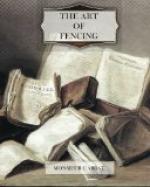Most young Beginners endeavour to hit at any Rate, instead of practising what would be beneficial to them, but instead of deceiving others they deceive themselves, by practising less how to form themselves and push according to Rule, than how to spoil their Bodies, and destroy the Solidity of the Principles: Some use themselves to push with the Wrist only, without the Foot, which is dangerous, by reason of the too great Measure; others with as little Reason, and as much Danger, place themselves without binding the Blade, and thrust under the Wrist; in the one the Situation of the Guard is good for nothing, and in the other there is no Defence if the Adversary thrusts at that time: Others deceive by making a Time or Motion when they are placed, but the pushing at the Wall requires only the Justness and Swiftness of the Thrust; others put themselves very near baulking the Measure, which may be done four Ways, tho’ the Left-foot may be in it’s proper Place, and kept firm in the Thrust; the first is done by marking or bringing forward the Point of the Left-foot, keeping it a little in, then advancing the Heel, which gives more Measure; secondly, by keeping back the Body on a Lunge, you deceive the Measure and hit by abandoning it forward, which gives it a greater Extention, thirdly, by raising or carrying the Wrist too high, or too much to one Side, which shortning the Thrust, makes it believed that you are out of Reach, but according to the Rule and Line you are too much in Reach; fourthly, some take Measure by holding the Thumb on the Body of the Guard, and when they have a mind to hit they hold it on the Middle of the Handle, with the Pommel in the Hand, which also gives a greater Length.
When you have for some time used yourself to push and parry at the Wall, according to the Rules that I have laid down, you must, (tho’ ’tis not the Rule of Schools, especially when you push with Strangers,) you must I say, when you push with a Scholar of your own Master, push and parry a Thrust alternately, disengaging, and then do the same Feinting, and sometime after you shou’d make the other Thrusts, telling one another your design, which makes you execute and parry them by Rule, especially if you reflect on the Motions and Postures of the Lunges and Parades. Being a little formed to this method, you may, being warned of the Thrust, parry it, telling the Adversary where you intend your Riposte, which puts him in a condition to avoid it, and gives him room to redouble after his Parade, either strait or by a Feint, at which you are not surprised, expecting by being forewarned the Thrust he is to make, which puts you easily on your Defence and Offence: by this manner of Exercise, you may not only improve faster, but with more art, the Eye and Parts being insensibly disposed to follow the Rule, whereas without this Method, the difference that there is between a lesson of assaulting a Man who forewarns you, helps you, and lets you hit him, and another who endeavours




